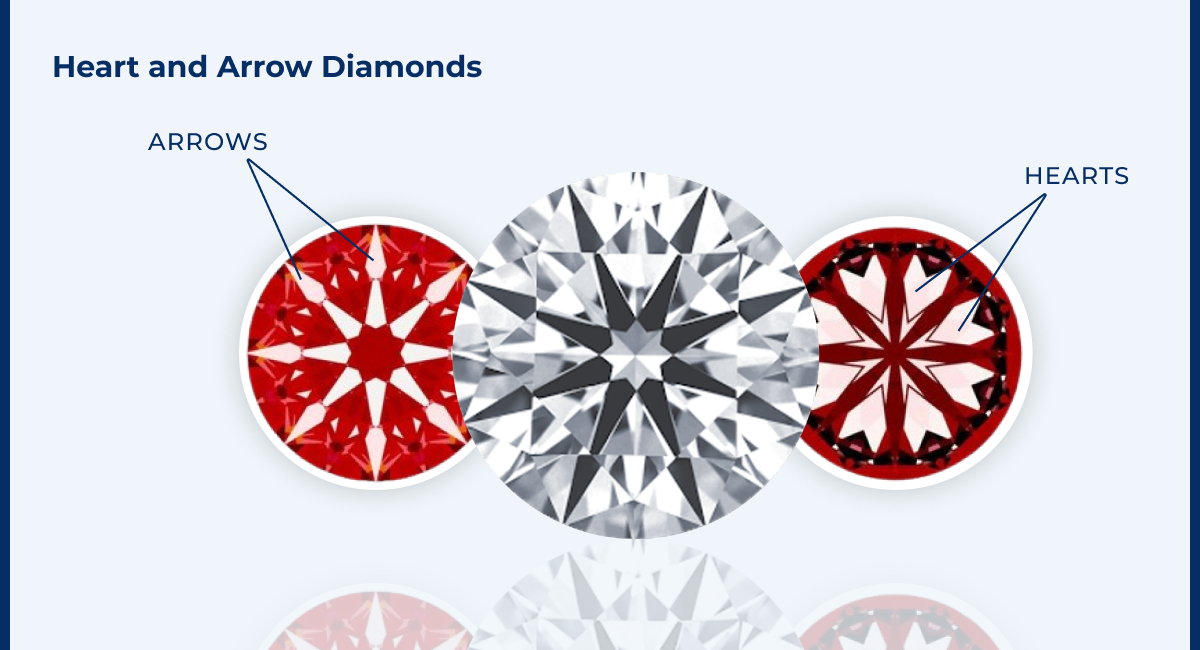Hearts and Arrows Lab Diamonds: A Symbol of Precision and Romance
Release time:
2025-03-24
source:

The concept of Hearts and Arrows diamonds traces its roots to advancements in lab diamond cutting over the past century. In the 1870s, American cutter Henry D. Morse emphasized aesthetics, laying the groundwork for future innovations1. By 1919, Belgian mathematician Marcel Tolkowsky defined the angles critical to the "Ideal Cut," later standardized by the GIA.
A breakthrough came in 1980 with Japanese inventor Kazumi Okuda’s Firescope, a 3D visualization tool that enabled Super Ideal cuts like those by Kioyishi Higuchi, characterized by optical symmetry and strict tolerances14. This technology revealed an eight-rayed star pattern, a precursor to the iconic Hearts and Arrows motif. By the mid-1980s, brands like Eightstar and Apollon refined these cuts, discovering that face-up diamonds viewed through the Firescope displayed eight symmetrical hearts (from the pavilion) and eight arrows (from above)1. Japanese Gemological Laboratories later named these diamonds "Hearts & Arrows," inspired by Cupid’s arrow in Greco-Roman mythology.
Technical Excellence
Hearts and Arrows diamonds represent the top 1% of round brilliant cuts, celebrated for unmatched optical precision. This refers to the uniformity of facet alignment, size, and shape across the diamond’s 3D structure1. When viewed through specialized tools like the Hearts and Arrows Scope, the pattern emerges: eight hearts from below and eight arrows from above, requiring magnification to appreciate fully.
While GIA and AGS certifications denote high cut grades, they do not assess optical precision—a feature evaluated exclusively via the Hearts and Arrows Scope. Notably, not all "Ideal Cut" diamonds exhibit this pattern, debunking a common myth1. For lab-grown diamonds, IGI certification is the benchmark for verifying H&A characteristics.
Optimal Proportions and Performance
Key specifications ensure maximum brilliance:
Pavilion angle: 40.8° maximizes light return.
Crown angle: 34.5° balances brightness (white sparkle) and fire (colored dispersion).
Facet ratios: A 50% star facet and 75% lower girdle facet enhance symmetry and adaptability to lighting conditions.
These diamonds outperform conventional cuts due to their meticulous craftsmanship, creating a multi-dimensional "dazzle effect" that makes them appear larger.
Modern Relevance and Certification
Hearts and Arrows diamonds blend technical mastery with romantic symbolism, appealing to buyers seeking timeless elegance. While natural H&A diamonds are certified by GIA, lab-grown versions rely on IGI for authentication. Brands like ITEN lab diamond have further innovated with patented cuts like the "Ten Hearts and Ten Arrows," featuring 81 facets for superior light reflection, though this differs from the classic 8-pattern H&A.
Choosing a Hearts and Arrows lab diamond
Verify optical precision: Use a Hearts and Arrows Scope, as traditional certifications omit this criterion.
Prioritize proportions: Ensure angles and facets align with ideal specifications.
Consider lab-grown options: IGI-certified lab diamonds offer ethical and cost-effective alternatives.
Related news
CONTACT
Add : A2102 World Trade Center, Luoyang City, China
P.C: 471000

Online Message
